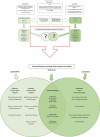Work situation and professional role for midwives at a labour ward pre and post implementation of a midwifery model of care - A mixed method study
- PMID: 33256567
- PMCID: PMC7717870
- DOI: 10.1080/17482631.2020.1848025
Work situation and professional role for midwives at a labour ward pre and post implementation of a midwifery model of care - A mixed method study
Abstract
Purpose: To explore and analyse the experience of work situation and professional role for midwives at a labour ward pre and post the implementation of a midwifery model of care (MiMo). Methods: A simultaneous mixed method was used. The qualitative core component departed from three focus group interviews (n = 16 midwives). Secondary inductive and deductive content analysis was performed using an unconstrained matrix to make a corresponding comparison of the different time points. The supplemental component was a quantitative survey about the work situation (n = 58). Results: The qualitative results pre the implementation showed three categories: Balance between Women and Organization, Midwives-Diverse as both Profession and Person, and Strained Work Situation. Post the intervention they transformed to Balance between Midwifery and Organization, Midwives-An Adaptable Profession, Strained Work Situation, and a new category Ability to concretize midwifery was found. There were no significant differences in the measures of work situation in the quantitative analyses. Conclusions: The synthesized findings based on the qualitative part show that MiMo has a potential to strengthen the professional role and midwifery practice. As such, MiMo has the capability to offer benefits to the labour wards with additional considerations.
Keywords: Midwifery; burnout; demand and control; mixed method; professional role; stress; work situation.
Conflict of interest statement
The authors have no financial or other relationships to declare which might lead to a conflict of interest.
Figures



References
-
- Antonovsky, A. (1987). Unraveling the mystery of health: How people manage stress and stay well (1 ed.). Jossey-Bass.
-
- Antonovsky, A. (1996). The salutogenic model as a theory to guide health promotion. Health Promotion International, 11(1), 11–14. 10.1093/heapro/11.1.11 - DOI
-
- Antonovsky, A. (2005). Hälsans mysterium (2. utg./förord av Lennart Levi ed.). Natur och kultur.
-
- Bakker, A. B., & Demerouti, E. (2007). The job demands-resources model: State of the art. Journal of Managerial Psychology, 22(3), 309–328. 10.1108/02683940710733115 - DOI
MeSH terms
LinkOut - more resources
Full Text Sources
Research Materials
